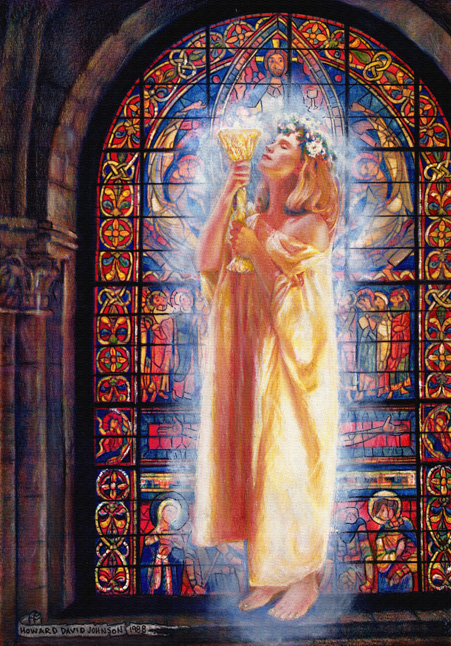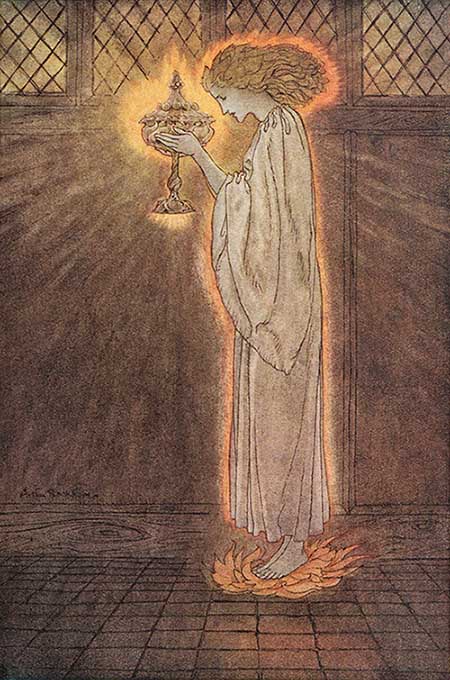Grail
-
Grail
Graal, Graaus, Graaux, Gradale, Graï, Grasal, Greal, Grëaus, Sangradale, SangrealA mystical dish, bowl or cauldron of plenty. [More]
-
Grail Castle
The castle, known as Carbonek or Corbenic, in which the Grail was housed and where it was guarded by the Fisher King. It stood in the heart of the Grail Kingdom. It is called Munsalvæsche in Wolfram’s Parzival, Illes in Diu Crône, and Corbenic in the Vulgate and Post-Vulgate Cycles.
In Perlesvaus, the Grail Castle was approachable only by a number of perilous bridges, guarded by two stone lions who mauled the unworthy. After the Fisher King’s death, it was conquered by the King of the Castle Mortal. All its holy artifacts disappeared until it was re-conquered by Perceval. A chapel outside the castle held the body of Joseph of Arimathea. It was also called Eden, the Castle of Joy, and the Castle of Souls. Anyone who died there went to heaven. After Perceval re-conquered it, Joseus the hermit served as its steward. Eventually, it crumbled to ruin, although the chapel remained in perfect condition.
Chrétien de Troyes does not give the Grail Castle a name. He describes it as a square tower of dark gray stone, flanked by two smaller towers, with hall, arcade, and drawbridge; all located in a valley between a river in a deep, rocky bed and a wood. The building is at first invisible to Percivale, even after the Fisher King in his boat has described it; its finally coming into Percivale's view could have either a mystical explanation, or a nature one involving angles and perspective. When he meets his cousin (the Fisher King's niece) next day, however, she remarks that there is no lodging within forty leagues along the way he has come. Hearing that he has lodged comfortably, she knows it could only have been at her uncle's house. She does not identify it as an Otherwordly outpost, but her general reaction seems to suggest as much.
The description of this castle and its locale somewhat resembles those of both Gornemant's Gohort and Ygerne's (Igraine) Rock of Canguin in the same romance.
-
Grail Family
The elite clan of nobles in Wolfram’s Parzival who were charged to keep and protect the Grail. The eldest son from each generation was chosen to be Grail King - the first Grail King was Titurel, followed by his son Frimutel. After Frimutel, it fell to Anfortas (Wolfram’s Fisher King), to Perceval, and lastly to Perceval’s son Loherangrin.
Other members of the Grail Family included Perceval’s mother, aunts, and uncles: Herzeloyde, Trevrizent, Schoysiane, and Repanse de Schoye. The tradition of the family was that the members not chosen to be the Grail King would disperse from Munsalvæsche and become rulers of various lands. The family was in command of a group of Grail Knights called Templars. In Diu Crône, Heinrich von dem Türlin re-interpreted the Grail Family as a cursed clan who Gawain saves from a living death.
-
Grail Hero
The knight who seeks the Grail and, generally, becomes its new keeper upon achieving it. In the earliest stories of Chrétien, Wolfram, and their adapters, the Grail Hero is Perceval (or, in Heinrich von dem Türlin’s Diu Crône, Gawain). The Vulgate Queste del Saint Graal and later stories, however, give the primary honor to Galahad and put Perceval in a secondary position, along with Bors.
-
Grail Keeper
The Maimed King, Grail King or injured Fisher King who guards the Holy Grail in the Grail Castle. The Holy Grail sustains him while he waits for the purest knight to ask the Grail Question, thus releasing him from his enchantment and achieving the goal of the quest. [See Fisher King.]
-
Grail King
The leader of the family who kept charge of the Grail, called the Fisher King by some writers, but sometimes given as a separate ruler.
In Wolfram, the succession of Grail Kings is given as Titurel, Frimutel, Anfortas, Perceval, and Loherangrin; in the Vulgate romances, they are Joshua (a follower of Joseph of Arimathea), Aminadap (Aminabad), Carcelois, Manuel, Lambor, Pellehan, and Pelles. Sometimes the Grail King is the same as, or becomes, the Maimed King. The Grail King ruled the Grail Kingdom from the Grail Castle.
-
Grail Kingdom
The land which contained the Grail Castle. The land was called Terre Salvaesche by Wolfram, and the Strange Land, or Listenois, by the Vulgate romances. In the Vulgate sources, it became the Waste Land when the Fisher or Maimed King received his wound.
-
Grail Knights
TemplarsIn Wolfram’s Parzvial, an elite group of knights, sometimes called Templars, charged with guarding the Grail Castle.
-
Grail Legend, The
How the Grail Quest came to be. [More]
-
Grail Maiden
Any of a number of maidens who lived at the Grail Castle and were part of the Grail Procession witnessed by Perceval. The chief Grail Maiden was in charge of bearing the Grail. In Wolfram, this is Repanse de Schoye. Chrétien, who seems to have first described her, does not tell us who she is.

The Grail Maiden, Howard David Johnson, 1988
According to D.D.R. Owen, he describes the scene in such a way as to allow the possibility that the radiance issues from the damsel rather than from the object she carries.
See also
Ampflise | The Legend of King Arthur
Clarischanze of Tenebroc | The Legend of King Arthur
-
Grail Procession
The procession observed by Percivale/Perceval at the Grail Castle when the Grail was carried, according to Chrétien by a squire with a bleeding lance, two squires carrying ten-branched candlesticks, a damsel with the Grail itself and a final damsel with a plate.

The Grail Maiden, Arthur Rackham, 1917
In the Didot Perceval, the procession consisted of two youths carrying a large spear from which blood freely flowed, followed by a damsel carrying a salver on which there was a head swimming in blood. It is worth noting that the Grail Procession only ever appears in works where it is Perceval who achieves the Grail.
-
Grail Quest
How the Grail Quest came to be. [More]
-
Grail Question
It is common in folklore and fairy tales that there is a theme of a land under a spell, which could only be broken by asking the right question. The Grail Question is the question to be asked of the wounded Fisher King in order to break the enchantment under which he and his lands are held, by the quest knight. In Perceval, by Chrétien de Troyes, the question is:
Who does the Grail serve?
The question is really twofold:
What is the Grail?
Whom does it serve?At first Perceval did not achieve the Grail simply because he forgot to ask this question, or didn't dare to since his tutor, Gornemant of Gohort, had warned him not to talk too much. He did not make the same mistake twice and asked the question needed when he visited the castle for the second time and completes the adventure.
Wolfram von Eschenbach's version of the question is:
What ails you [the Grail King]?
In Diu Crône, by Heinrich von dem Türlin, the Grail company were in a state of living dead and were freed when Gawain roared
For the sake of God and His majesty, tell me the meaning of this large assembly and miracle!
Gawain partially heals the Fisher King's land by asking about the Bleeding Lance, but he falls asleep before he can ask about the Grail, in the First Continuation of Chrétien's Perceval.
-
Grail Spear
Grastian the CastellanAn alternative way of referring to the Lance of Longinus, or the Bleeding Lance.
-
Grail Sword
In each Grail romance, the Grail appears as the most important of three objects associated with the Fisher King: the Grail, a Bleeding Lance, and a sword. The sword is perhaps the most mutable of the three.
In Chrétien’s Perceval, the sword was fashioned by the smith Trebuchet and given to Perceval by the Fisher King. The magnificent blade had a hilt of ruby. In Chrétien’s version, Perceval is warned that it will shatter if he uses it in battle, and that it will have to be repaired by Trebuchet in Cotatre. In Wolfram’s Parzival, Sigune tells Perceval that the sword is good for one blow, but that it will shatter on the second and would have to be repaired by immersing it in the spring near Karnant called Lac. Perceval shattered it in a duel and did manage to mend it in the spring.
In both the First and Second Continuations of Perceval, it is said that the perfect Grail Knight could mend the sword, which had become broken through unknown means. Gawain is unable to join the pieces in the First Continuation (nor in the Vulgate Lancelot). Gawain learns that the Grail Sword was once used to strike a blow that "laid the whole country of Logres to waste", perhaps alluding to the role of the Sword with the Strange Hangings in the Vulgate texts. In the Second Continuation, Perceval is able to put the sword together, but the hairline fracture that remains bespeaks Perceval’s failure to achieve complete perfection. We learn in the Third Continuation that it was broken when a knight named Partinal used it to kill Goondesert, the Fisher King’s brother. In the Fourth Continuation, Perceval is finally able to mend it completely.
In Perlesvaus, the Grail Sword is identified with the sword which beheaded St. John the Baptist. Gawain needed it to enter the Grail Castle, and he recovered it from King Gurguran as a reward for dispatching a terrible giant plaguing Gurguran’s land. The sword was subsequently stolen by the King of the Watch, but was returned. Gawain delivered it to the hands of the Fisher King, which somewhat alleviated his subsequent failure to ask the Grail Question.
In Heinrich von dem Türlin’s Diu Crône, the Grail Sword is simply awarded to Gawain upon completion of the Grail Quest. In the Vulgate Queste del Saint Graal, it is called the Broken Sword, having been shattered when it struck Joseph of Arimathea, and it is mended by Galahad at the conclusion of the Grail Quest. However, in the Vulgate romances, the importance of the Grail Sword is eclipsed by the magnificent Sword with the Strange Hangings; Galahad’s mending of the Grail Sword is simply one episode in a long line of tests that serve to prove Galahad as the greatest knight.
-
Grail Table
A precursor to the Round Table, modeled after the table of the Last Supper and used by the followers of Joseph of Arimathea. When the crops of the Grail fellowship failed (signifying unworthiness within the company), Joseph had the table constructed to weed out the sinners among the group. Bron, later known as the Rich Fisher (Fisher King), caught a fish that was multiplied into thousands in the presence of the Grail. The unworthy, however, found themselves unable to physically sit at the Grail Table.
The Grail Table was made of silver. Like the Round Table, it had a Perilous Seat that destroyed anyone who sat in it. It also had a Feared Seat reserved for Josephus, Joseph of Arimathea’s son. The fate of the Grail Table after Joseph’s time is unclear, but at the conclusion of the Grail Quest, Galahad, Perceval, and Bors were served mass at the table. In an Irish version of the Grail Quest story, the table is last found in the ship that bore Lancelot and the body of Perceval’s sister.
See also
Escholarz | The Legend of King Arthur
